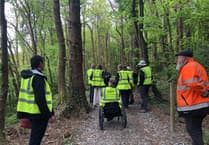An empty Welsh chapel could be transformed into a new coffee roastery, cafe and holiday accommodation. Gwynedd Council has received a full planning application for the change of use of the historic Capel Bryn Rodyn site.
The area comprises of a former chapel building situated beside a residential property to the east. The old chapel at Dolydd, near Groeslon is also referred to in the council planning documents with the alternative spellings of “Bryn Rhodyn” and “Brynrodyn.”
The once thriving former religious site is located along the old road between Penygroes to Caernarfon in a rural area of Gwynedd. The latest scheme, although still in the early planning stages, is hoped could breathe new life into the old building.
The proposal has been submitted by Steffan Huws of the Poblado coffee company through agent Geraint Efans, Pensaer. The applicant is already involved in running a successful and popular artisan coffee roast at Y Barics in Nantlle.
The chapel plans call for a change of use of the former chapel to become a café and a roasting coffee shop. The proposals would also see the development of a short term holiday let on the first floor of the existing building.
The planning application also describe the site’s proposed use for coffee bean roasting, a visitor centre and barista training. According to the Coflein website the original Bryn Rodyn Methodist Chapel was built in 1773.
The once austere Welsh Calvinist centre of worship was once a much larger building. Over the years the site underwent a number changes and alterations, including building demolition, some years ago.
Modifications had also been made in 1798 and 1830, the chapel was rebuilt in 1869 in what the historic building website describes as a “Romanesque style of the gable entry type.”
The chapel has been originally built by architect Richard Owen of Liverpool the website also states. A survey on the vacant building said it had found house sparrows nesting within the fascia of building on the southern side.
A bat survey also described some “sections of the buildings proposed for development used by roosting bats.” Three different types of bat species were identified and the building was identified as being used “occasionally as a day and night roost.”
A European Protected Species Development Bat Licence would need to be applied for before any works started, the report states.
Although bat droppings had been found “no huge accumulations of bat droppings associated with maternity roosts were found within any of the buildings at Capel Brynrodyn,” the survey noted.
The report proposed mitigation work to protect any potential bats there, including leaving the southern attic as a dedicated bat roost.




.jpeg?width=209&height=140&crop=209:145,smart&quality=75)
Comments
This article has no comments yet. Be the first to leave a comment.